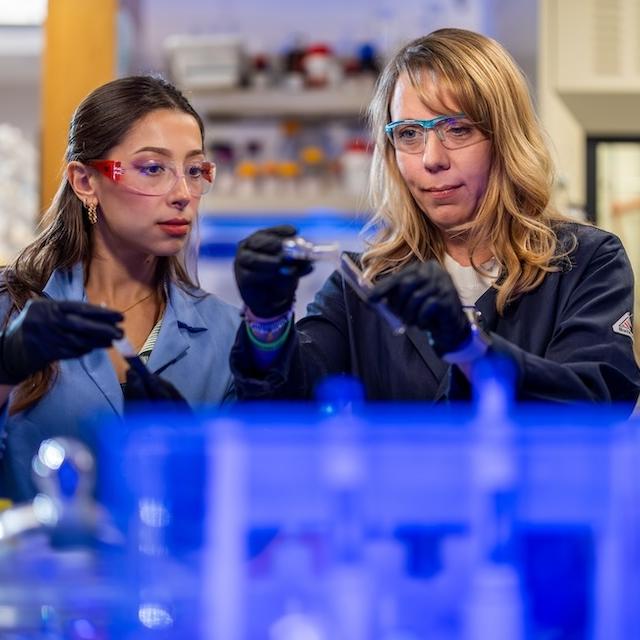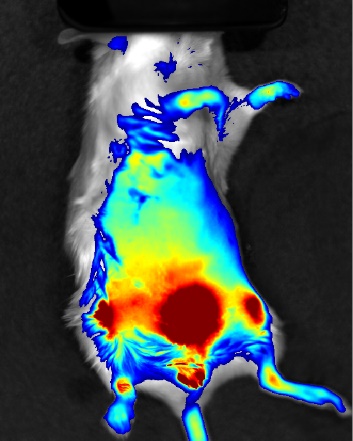
WelchX Pilot Grants Spark Chemistry Research at TCU
Chemistry professor Kayla Green takes a moment in a quiet ballroom before walking
into the WelchX Pilot Grant retreat this summer. The four-day intensive ends with
professors like Green developing a full research proposal with a stranger.
“It was like Chemistry Camp,” Green said. “It was an incredibly well-structured environment
and such a positive experience.”
The retreat began with researchers pairing off, exchanging ideas and exploring each
other’s work. That is how Green met assistant professor Samantha Kristufek of Texas
Tech University. They immediately connected over their shared focus on recycling critical
minerals – Green in the development of earth-abundant, metal-derived catalysts and
Kristufek in the development of polymers for those catalysts.
Their complementary research sparked an instant partnership. Now, they faced the WelchX
challenge of developing a proposal in just 24 hours.
The WelchX Pilot Grant program, funded by The Welch Foundation, one of the nation’s
largest private funding sources for fundamental chemical research at Texas universities,
is designed to inspire collaboration and innovation. The program advances the foundation’s
mission by supporting bold new ideas from researchers across the state.
“WelchX brings Texas researchers together to topically focused chemistry meetings,
stimulating them to ideate challenging issues of our time, while fostering lasting
connections and increasing the density of research ties across the state,” said Benjamin
Janesko, professor and chair of TCU’s Department of Chemistry.
At this year’s WelchX retreat, held in Houston, research on climate-smart chemistry,
clean energy and clean water was discussed. Then 18 researchers from 12 universities
paired up and submitted proposals for $100,000 collaborative pilot grants.
The 24-hour window is to create the kind of urgency that leads to innovation.
Green and Kristufek’s research is “CIRCUIT: Critical Ion Recovery using Conductive
and Ultrafiltration Intelligent Technology,” exploring innovative ways to recover
critical metal ions using recyclable materials with the goal of paving the way for
advances in technology and sustainability.
Specifically, the project focuses on developing filters capable of extracting critical
minerals from discarded electronics such as smartphones and computers and reintroducing
the minerals into the technology supply chain.
“We’re researching molecules that can ‘sponge up’ critical minerals, especially copper
and lanthanides,” Green said.
These minerals are commonly used in technology products but do not naturally break
down. In the U.S., recycling these materials is complicated and costly. The CIRCUIT grant seeks to develop more efficient, cost-effective recovery processes, making
it easier to recycle electronic devices.
The ultimate goal is to work with a local company to develop critical mineral feedstocks.
With companies like Apple investing $500 million alongside Fort Worth’s MP Materials
to produce American-made rare earth magnets from recycled elements, Green’s work is
well-positioned to contribute to ongoing innovation in sustainability and technology
manufacturing.
Janesko was also awarded a pilot grant along with Masud Rana, a computer scientist
at Lamar University. Janesko and Rana’s research is “Cyber Twin Chemical Ensembles
for Near-Infrared-Emitting Graphene Quantum Dot Therapeutics,” building a deeper understanding
of graphene quantum dots (GQDs) developed by Anton Naumov, a physics professor at
TCU. The Naumov group’s biocompatible GQDs absorb and emit near-infrared light, a
property that allows them to be visualized through skin and muscle, opening the door
to potential medical applications.
However, researchers don’t yet fully understand why GQDs absorb near-infrared light,
which makes improving the material challenging. Janesko and Rana aim to solve this
by combining quantum chemistry calculations, machine learning and experimental data
to better understand the phenomenon. If successful, their findings will support Naumov’s
group in refining the material for therapeutic uses.

Green and Janesko and their collaborators will spend the next year building their
pilot projects to present to The Welch Foundation.
Both Green’s and Janesko’s research highlight the TCU chemistry department’s impact
on critical challenges facing Texans and beyond. The department’s labs foster collaboration
among undergraduate researchers, Ph.D. candidates, postdoctoral fellows and faculty
across multiple subdisciplines of chemistry. Students actively contribute to the work,
often presenting their findings at local, national and international conferences and
publishing with faculty members.
What began as a 24-hour challenge has grown into yearlong projects with the potential
to advance sustainability and human health, shaping the future of chemistry and the
communities it serves.
Read more about the WelchX Pilot Grant Program, funded by The Welch Foundation.
